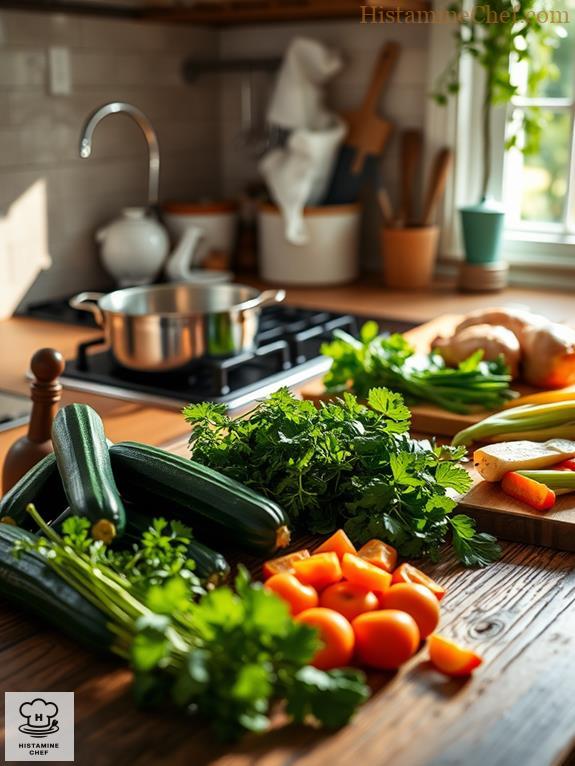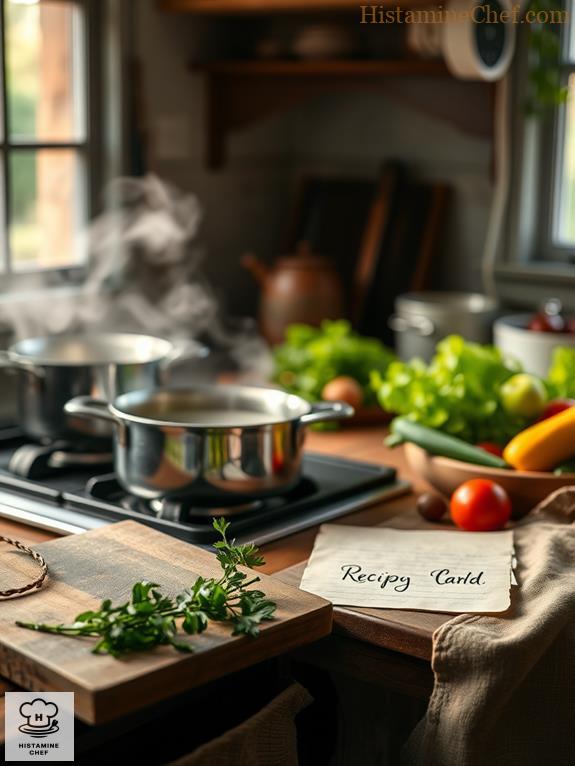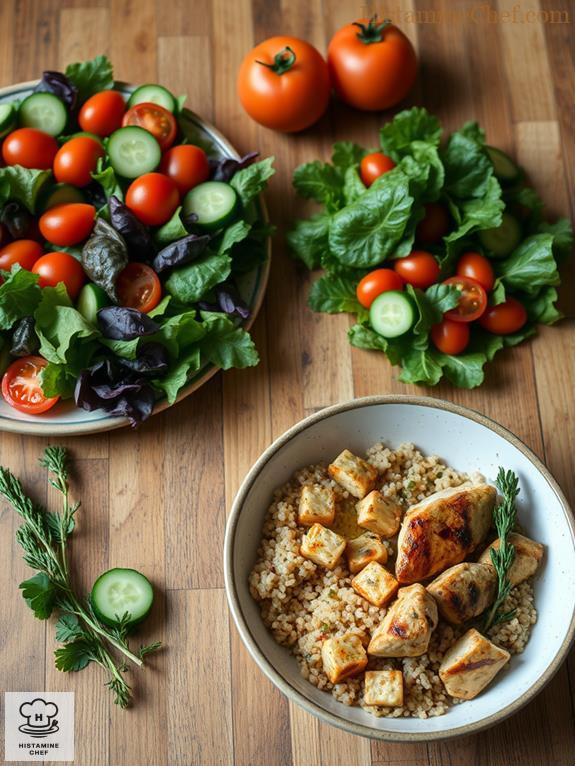Ever wondered how to make your favorite dishes histamine-friendly? I’ve cracked the code!
I dive into the SIGHI list, swapping high-histamine culprits for safe alternatives. Fresh apples replace aged cheese, and almond milk steps in for cream.
I’ve become a pro at poaching and steaming, keeping histamine levels in check. My kitchen’s turned into a flavor lab.
Who knew zucchini noodles could be so exciting? It’s all about getting creative and embracing the challenge.
Trust me, with a little experimentation, you’ll be whipping up delicious, worry-free meals in no time!
My Histamine-Friendly Dinner Party Disaster
I once hosted a dinner party, determined to serve histamine-friendly dishes. Excitement turned to panic when I realized I’d used tomato paste – a histamine bomb!
I frantically improvised, whipping up a quick zucchini sauce. My guests loved it, none the wiser.
It taught me to always double-check ingredients and have backup plans. Now, I’m the queen of histamine-free entertaining!
Understanding Histamine Intolerance

Histamine intolerance can be a perplexing condition that affects many people. Have you ever eaten something delicious, only to feel uncomfortable later? That’s your body’s histamine response at work!
This condition often arises when there’s an imbalance between the amount of histamine consumed and the body’s ability to break it down. To manage this, you can adopt specific dietary strategies. Start by checking the SIGHI list for foods that score 0 or 1—these are your safest bets! Think fresh fruits like apples and blueberries, or veggies like carrots and zucchini.
The SIGHI list provides valuable insights on histamine levels in foods.
Avoid high-histamine foods like aged cheeses or processed meats—trust me, your tummy will thank you! I write this blog, Histamine Chef, to help you navigate those tricky choices while still enjoying food.
Low Histamine Cooking Techniques

Managing histamine intolerance doesn’t just stop at choosing the right ingredients; it also involves employing specific cooking techniques that help minimize histamine buildup.
Utilizing batch cooking methods can be particularly beneficial, as they allow you to prepare meals in bulk while controlling histamine levels effectively. I love batch cooking, which means I whip up meals in advance. This makes meal prep a breeze and helps with ingredient storage!
Just be sure to use clean cooking utensils to avoid cross-contamination.
When scaling recipes, stick to low histamine foods from the SIGHI list, like fresh chicken or quinoa.
Ingredient Substitutions for Recipes

When cooking with histamine sensitivity in mind, I often find that simple ingredient substitutions can make a big difference.
Exploring smart substitutions can help you adapt your favorite dishes while keeping them safe. Here are some swaps I love:
- Herb alternatives: Try fresh basil or parsley instead of restricted spices.
- Sweetener swaps: Use maple syrup or honey instead of artificial sweeteners.
- Nut replacements: Go for pumpkin seeds instead of walnuts or pecans.
- Dairy options: Almond milk or coconut milk can replace regular dairy.
These changes not only keep dishes safe but can also add unique flavors.
I recall the first time I swapped out tomatoes for roasted carrots in a sauce; the sweetness was a delightful surprise!
Safe Cooking Methods

When it comes to cooking safely with histamine sensitivity, I’ve found that using gentle techniques can really make a difference.
Poaching, in particular, is a fantastic method because it allows you to cook food gently in water or broth, preserving its nutrients and flavor without the histamine build-up that can occur with other cooking methods.
Think steaming, poaching, or sautéing—these methods keep your food fresh and tasty without triggering pesky histamine reactions.
Plus, avoiding long fermentation processes helps keep your meals safe and delicious; nobody wants a surprise from their dinner plate!
Gentle Cooking Techniques
In the kitchen, utilizing gentle cooking techniques can greatly reduce histamine release in foods, making meals safer for those with histamine sensitivity.
Here are some methods I love:
- Gentle steaming
- Slow roasting
- Mild sautéing
- Light poaching
These techniques help maintain the integrity of ingredients while keeping flavors vibrant. For example, gentle steaming vegetables not only preserves their nutrients but also makes them bright and tender.
I often opt for slow roasting meats at low temperatures, allowing them to soak up the natural juices without creating histamine.
When you’re mindful about how you cook, you can enjoy delicious meals without the worry. Who knew cooking could be both safe and fun? Let’s get our gentle cooking game on!
Fresh Ingredient Selection
Selecting fresh ingredients is essential for those managing histamine sensitivity. I can’t stress enough how much seasonal produce can make a difference! Think about those juicy, ripe peaches in summer or crisp apples in fall.
When I shop, I always prioritize local sourcing. It not only supports farmers but also helps me find fresher ingredients with lower histamine levels.
You see, fresh veggies like carrots and zucchini are my go-tos, while I steer clear of restricted ones like tomatoes and spinach.
It’s like playing a game of food tag—only the safe ones get to join my plate!
Avoiding Long Fermentation
Long fermentation can be a hidden trap for those with histamine sensitivity, so I always opt for cooking methods that keep my meals safe and enjoyable.
Here are some fantastic alternatives I love:
- Quick pickling veggies for a zesty crunch.
- Using fresh herbs to add flavor without the wait.
- Choosing fresh meats and avoiding processed options.
- Cooking with allowed oils for healthy fats.
Fermentation alternatives are key! Instead of sauerkraut, I whip up quick pickled carrots or cucumbers. They’re delicious and easy!
Trust me, I’ve learned it the hard way—those long-fermented foods can sneak up on you.
By focusing on fresh, quick preparations, I can savor my meals without worrying.
Let’s keep it safe, tasty, and fun!
Flavoring Without High Histamine

When I’m looking to enhance the flavor of my meals without triggering histamine sensitivities, I turn to fresh herbs and certain spices that stay well within the safe zone.
Utilizing herb swaps like basil, oregano, and thyme can really elevate a dish while ensuring a histamine-friendly experience. I love experimenting with spice alternatives like turmeric and ginger—they offer fantastic flavor without the histamine hassle!
For taste balancing, low histamine sauces and safe marinades are my go-tos.
Don’t forget aromatic infusions; they can make your kitchen smell heavenly!
Remember my seasoning tips: always check the SIGHI list for safe ingredient pairings.
With a little creativity, we can create exciting flavor profiles while keeping our meals delicious and safe! Who knew histamine sensitivity could taste this good?
Sample Low Histamine Recipes

Creating delicious low histamine recipes opens up a world of flavorful possibilities while keeping my meals safe and enjoyable. Incorporating dairy-free cheese alternatives can add a creamy texture to dishes without triggering histamine responses.
Here are some ideas to inspire you:
- Simple snack ideas like rice cakes topped with almond butter.
- Breakfast alternatives such as quinoa porridge with fresh berries.
- Quick meal options like stir-fried vegetables with chicken.
- Dessert recipes featuring coconut milk panna cotta with mango.
I love experimenting with salad inspirations by combining fresh greens with light dressings.
Pasta variations using rice noodles tossed with sautéed veggies are delightful too!
And don’t forget about smoothie combinations—try blending almond milk, blueberries, and a dash of honey.
These recipes make me feel good, and I hope they bring you joy too!
FAQ
Can I Use Frozen Vegetables Instead of Fresh Ones?
Using frozen vegetables is like having a reliable friend always ready. I love their convenience and nutritional benefits. Just steam or sauté them, and you’ll enjoy delicious, safe meals without worrying about freshness!
How Do I Know if a Food Is High in Histamine?
I check food labeling for ingredients, especially fermented foods, since they often trigger histamine reactions. Everyone’s individual tolerances vary, so I recommend keeping a journal to track what works best for you.
Are There Specific Brands of Low Histamine Foods to Trust?
I often research trusted brands for low histamine foods. I check ingredient labels carefully and rely on product sourcing information. Online resources help me find safe options that align with my dietary needs.
How Can I Store Leftovers Safely for Low Histamine Diets?
Did you know that 40% of food waste comes from leftovers? I always store mine in airtight containers and refrigerate them promptly. For safe reheating, I guarantee they reach at least 165°F to enjoy safely.
Can I Gradually Reintroduce Restricted Foods Into My Diet?
I’ve found that gradually reintroducing restricted foods works best. I use food reintroduction strategies and symptom tracking methods, ensuring I monitor my body’s reactions closely, keeping my health and safety as priorities throughout the process.
Summary
I’ve discovered that modifying recipes for histamine sensitivity can be a flavorful journey. By swapping high-histamine ingredients, I create delicious meals without triggering symptoms. It’s an ongoing adventure, and I’m excited to explore new culinary possibilities.
Have you modified recipes for histamine sensitivity? Share your experiences and favorite substitutions in the comments below.
Help spread awareness about histamine-friendly cooking by sharing this post on social media. Your support can help grow the Histamine Chef community and reach more people seeking tasty, low-histamine alternatives.


Leave a Reply